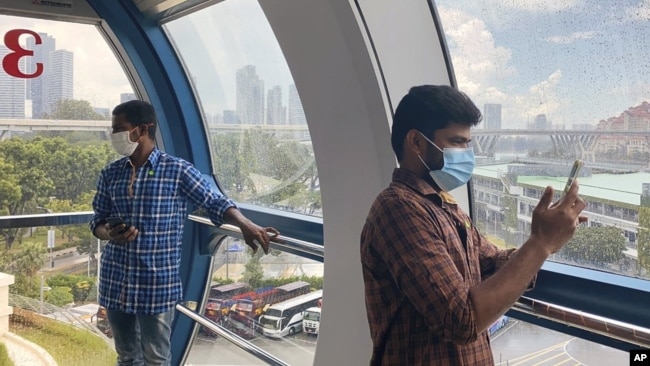観覧車と移民の思い
移民を受け入れるといことは、そのひとの人生、家族、宗教、価値観を共有するかんような社会が必要です。
この記事を聴いて、最後は胸が締め付けられるような思いでした。
今日も英語学び、世界を知ろう!!
- 移民労働者のためのシンガポールスカイラインの眺め
- A Singapore Skyline View for Migrant Workers
- A Singapore Skyline View for Migrant Workers
移民労働者のためのシンガポールスカイラインの眺め
A Singapore Skyline View for Migrant Workers
シンガポールの観覧車は、雨粒に打たれていました。
しかし、シンガポール・フライヤーに乗っている出稼ぎ労働者たちは気にしていないようでした。彼らは街のスカイラインを上から見ようとしていたのです。
※ skyline :空を背景として、都市の高層建築物や山岳の稜線などが描く輪郭線のこと。
彼らは、一般市民や企業からのプレゼントとして無料で乗車している、少なくとも2万人の労働者のうちのほんの一握りに過ぎませんでした。
ItsRainingRaincoatsというプログラムは、シンガポールの出稼ぎ労働者への優しさを広めるために数年前に始まりました。今年の1月からは、出稼ぎ労働者に寄付する乗車券の募集を開始しました。
ダイパ・スワミナサン氏は、このグループの創設者です。あるボランティアの方が、政府から支給される観光費を有意義に使う方法として、この乗り物を紹介してくれたそうです。
18歳以上のシンガポール国民には、1人あたり約74ドルのツーリズムマネーが支給されています。このお金は、アトラクションやホテル、ツアーなど、コロナウイルスの大流行で損失を出したビジネスに使われなければなりません。
スワミナサン氏のグループは、観覧車の運営会社や予約サイトと協力して、外国人労働者のためにチケットを入手しました。多くの人々は、外国人労働者がシンガポールに多大な貢献をしてきたことを理解しており、これは彼らにとって恩返しの機会であると考えています。
「与えることには大きな喜びがあります。それが一般の人々が私たちを支持する理由だと思います」とAP通信に語っています。
このグループは、チケットが届く限り、乗り物を企画し続けるといいます。
インタラクティブな空間への入場を含むチケットは、約26ドルです。
これは、シンガポールに住む70万人から80万人のうちの2%にあたるとスワミナサン氏は推定しています。
彼女は、観覧車の”密閉された”性質が、適していると言います。
ボランティアは、最近の訪問時に、顔のカバーをつけて1メートルの距離を保つように乗客に注意を促しました。
ガネサン・ティバガーさんは、他の移民労働者数人と一緒に最近訪れました。
悪天候のために一時的に乗り物が止まっている間、彼らは待っていました。いざ乗ってみると、高さ165メートルの車輪からはそれほど素晴らしい景色は望めませんでした。
しかし、34歳の彼にはそんなことは関係ありませんでした。見える範囲に注意を払っていました。そして、14年前にシンガポールに来たときと比べて、シンガポールがどれだけ変わったかを実感したのです。
早速、インドのタミル・ナードゥ州に住む家族のために写真を撮り始めた。
「私はこの旅を楽しみ、友人たちと一緒に楽しむことができて幸せです。シンガポールのおかげで、ここに来ることができました。」と彼は言います。
ティバガーさんのような労働者は苦労しています。彼らの狭い生活空間では、パンデミックの初期にコロナウイルスの感染率が高かったのです。
シンガポールで報告された6万人の感染者のほとんどは、移民労働者でした。昨年、感染率が高かったことで、混雑した生活環境、低賃金、医療の欠如といった彼らの状況がにわかに注目されました。
感染状況はコントロールされていますが、これらの労働者は一般の人々よりも移動に制限がありました。この規則は当局によって緩和されつつあります。
29歳のナタラジャン パンディアランジャンさんは、この制限が”本当に大変だった”と言います。最近、観覧車に乗ったように、息抜きができることに感謝しています。「私にもいろいろな思いがあります。でも、今、こうして乗っていると、幸せな気持ちになります」と語ってくれました。
A Singapore Skyline View for Migrant Workers
The Ferris wheel in Singapore was getting hit with raindrops.
But the migrant workers riding the Singapore Flyer did not seem to mind. They were trying to see the city skyline from above.
They were just a small number of at least 20,000 workers getting a free ride as a gift from members of the public and businesses.
The program ItsRainingRaincoats began a few years ago to help spread kindness to Singapore’s migrant workers. In January, it began calling for ride tickets to be donated to the workers.
Dipa Swaminathan is the group’s founder. She said a volunteer saw the rides as a meaningful way to use tourism money provided by the government.
Singapore citizens ages 18 and older have received about $74 each in tourism money. They must spend it on attractions, hotels and tours – all businesses that have lost money during the coronavirus pandemic.
Swaminathan’s group worked with the Ferris wheel operator and a booking website to get tickets for the foreign workers. A lot of people see that the workers have given so much to Singapore “and this is their chance to give back,” Swaminathan said.
“There’s a lot of joy in giving. I think that’s what causes the public…to support us” in these kinds of actions, she told The Associated Press.
The group will keep organizing rides as long as tickets come in.
A ticket, which includes entrance to an interactive space, costs about $26. There are currently enough tickets for 20,000 workers.
That is two percent of the 700,000 to 800,000 people who live in Singapore, Swaminathan estimates.
She said the “contained” nature of the Ferris wheel makes it a good fit.
Volunteers reminded the riders to keep their facial coverings on and keep a one-meter distance during a recent visit.
Ganesan Thivagar recently visited with a few other migrant workers.
They waited while rides were briefly stopped for bad weather. When it was time to go on, the 165-meter-high wheel did not offer such great views.
But that did not affect the 34-year-old. He was paying attention to the areas he could see. And he was struck by how much Singapore had changed since he arrived 14 years ago.
He quickly began taking pictures for his family, who live in India’s Tamil Nadu state.
“I am happy to enjoy the trip and enjoy together with my friends. Thanks to Singapore, (I get to) come here,” Thivagar said.
Workers like Thivagar have had a hard time. Their small living spaces had high coronavirus infection rates early during the pandemic.
Migrant workers have made up most of Singapore’s 60,000 reported cases. Last year, the high infection rates brought sudden attention to their situation – crowded living conditions, low wages and lack of healthcare.
Although the infection situation is under control, these workers have had more restrictions on movement than the general population. The rules are being eased by officials.
Natarajan Pandiarajan, who is 29, said the restrictions were “really difficult.” He was thankful for a break like his recent ride on the Ferris wheel. “Inside many feelings I also have. But this time now, coming on, happiness,” he said.
